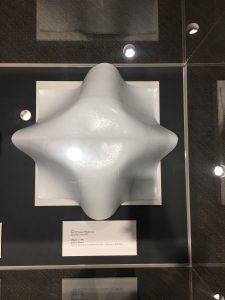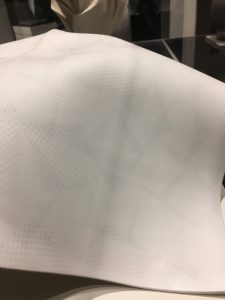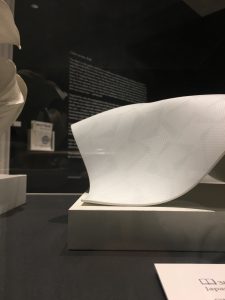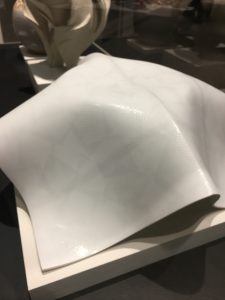Found in the Colors Across Asia gallery is an abundance of ceramic works, ranging in culture, region, and time period. Object, by Nagae Shigekazu in 1992, is an overall rectangular piece, with folds and curves found throughout that make it appear as though it is lying on top of something (Figure 1). The ceramic is made out of porcelain, that has been glazed, giving it a shiny finish. The surface of the piece, rather than being flat and smooth, has a texture reminiscent of snake skin. The subtle pattern changes throughout the piece, in that it doesn’t follow the same lines throughout, overlapping in some spaces more than others (Figure 2). The shapes in which he applied the texture also varies, lending a more geometric impression. Shigekazu could have approached it by using a textured textile of some sort to add the small circles to apply the texture onto the porcelain, and used different stencils for the glaze, to contribute to the coloring of the piece.


What strikes me the most about Object is its form. It appears to be a cloth covering a circular bowl. Rather than the sculpture being an object, it appears to me like it is covering the object. The piece has various large folds, all leading down to a corner that appears to be the only base of the sculpture. The corners, although very light, are the source of all the support of the sculpture and allow it to stand. Despite this, Shigekazu makes it so that the corners lift up, contributing to the light feel of the sculpture (Figure 3). Porcelain is known for its strength and resilience, which is what enables the piece to be held up by so little surface.
The making of this sculpture requires great expertise, in fact, working with porcelain requires great patience and knowledge as we have learned in class. Shigekazu’s manipulation of the material to achieve such a form is a departure from other pieces of porcelain typically seen in Asian art. In the Ackland’s description of the piece, it states that the clay is fired “at very high heat in [the] gas kiln, so that the fire molds the delicate porcelain into sleek, often unpredictable abstract sculptures.” Through our experience with clay and porcelain, I am assuming that Shigekazu first flattened out a slab of porcelain, ensuring that it was a uniform width and thickness throughout, then created the general shape, including the large circular shape at the top, and the wide folds found in the corners. Holding these shapes was probably accomplished by having something in the kiln to hold it up, with a very high melting point, so that it remained intact despite the high temperatures. Another theory could be that this piece was made with two different pieces, that were later attached together, this speculation is caused by a seam that runs right down the middle of the entire sculpture (Figure 4). However, there appears to be no cracks, and the seam appears to be a product of pinching rather than attachment. Nagae’s Shigekazu’s sculpture is a mystery in its form and its making, and provides even more questions towards the power of porcelain.

